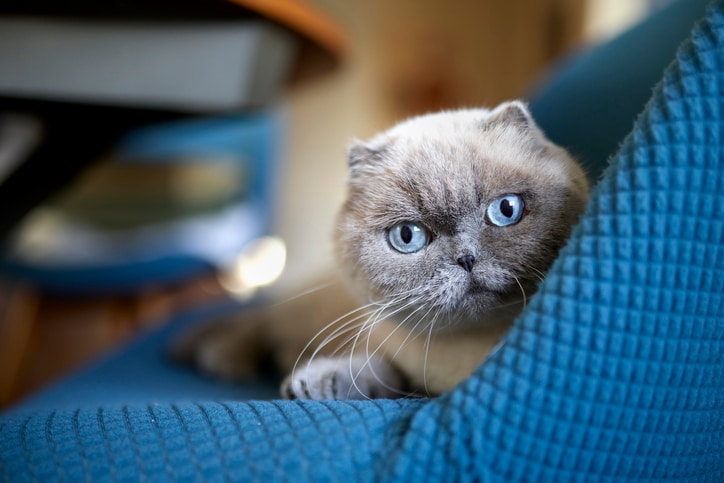Everyone knows the pretty Persian and magnificent Maine coon — and you might have a beloved domestic shorthair snoozing in a patch of sun next to you right now. For some cat lovers, though, only exotic cats — breeds that still bear the look of their wild ancestry or simply turn heads with their unusual appearances — will do.
The International Cat Association (TICA) registers many unusual breeds — but Cheryl Hogan, chair of the Scottish fold breed standards committee and former regional director for TICA, says they aren’t especially fond of the term “exotic cats” — it evokes the image of cats that are directly bred with wild animals, which is irresponsible and even dangerous.
It’s also important to find a responsible breeder when seeking a purebred cat of any kind, to ensure both that you’re getting what you paid for and that the kitten has been well cared for. “Purebred cats in general tend to be more prone to illness,” says Dr. Arnold Plotnick, veterinarian and founder of Manhattan Cat Specialists.
If you want a cat that will turn a few heads, but share the same domesticated nature as your average tabby, here are 10 breeds that look exotic, but make suitable house pets:
10 exotic cat breeds
1. Bengal
This active, playful cat is noted for its wildcat appearance and is a very “hot” breed right now. They are medium sized, with a short coat and rosette spots that resemble a leopard’s. Bengals are alert, curious and confident, but they can get aggressive if they’re bored, so they’re not so good with children.
2. Toyger
Always wanted a tiger as a pet? The toyger could be the cat for you. But this orange-and-black striped cat is about as friendly as its wild cousin is fierce. Toygers are intelligent and easy to train, and they get along well with children and other pets. The downside? They have nonstop energy and will keep you on your toes.
3. Selkirk Rex
This striking cat has thick hair arranged in tight waves and loose curls. They’re affectionate, fun-loving and social. The flipside of that is, of course, that they don’t well in isolation. Their coat also needs special care to look its best.
4. Lykoi
Just recognized in 2011, the lykoi breed’s name comes from the Greek world for wolf. One look at its werewolf face explains why. “Their coat looks very wiry and not soft at all, but that’s not true — they are very soft cats and just about as sweet as the day is long,” says Hogan. Lykois have a sweet personality and are highly intelligent. However, much like the wolves they resemble, they can also have a strong predatory instinct and can be overly protective of their toys, food or people.
5. Donskoy/Don Sphynx
Not related to the similarly hairless Sphynx, the Donskoy is a Russian breed whose hairless trait originally arose from a mutated gene. Their flocked and velour coats are soft and pleasant to touch, like chamois. They’re tender-hearted and intelligent, and their look is definitely striking. That distinctive look, however, may not be everyone’s cup of tea.
6. Ocicat
Not actually a cross with an ocelot, their short and smooth coats are banded everywhere except the tips of their tails, resembling an ocelot or a leopard. Ocicats are playful, good with children and dog-friendly, but you will have to put up with moderate shedding.
7. Scottish Fold
These kitties for their cute round faces and folded ears. Hogan, who breeds them, says, “They’re not wild and crazy — they’re not going to swing from the rafters. Kids can play dress-up with them.” They’re good with children and have soft, dense fur coats. But that soft coat will need a lot of grooming.
8. Japanese Bobtail
These gorgeous cats are represented in much Japanese art as the symbol of good luck. They have high cheekbones, large eyes and large ears, but their main distinguishing feature is of course their “pompon” tail. These cats are playful, curious and active — but that also means they’re always on the move.
9. Ragdoll
The ever-popular ragdoll is an “exotic” breed? Maybe you don’t think of them as all that unusual now, but the ragdoll was one of the first cats bred for specific physical characteristics. These large blue-eyed cats are known for going limp and relaxed when you pick them up, just like a ragdoll. They’re very affectionate, have super-soft fur and make great family cats. But they shed in spring and fall, so be prepared to vacuum.
10. Chausie
First intentionally bred in 1990 by crossing a wild jungle cat with a domestic cat, most chausies are now several generations beyond their wild ancestor and have fully domestic temperaments. These classic beauties boast tall and slender lines, with sculpted muscles reminiscent of their jungle cat ancestor.Chausies are playful and affectionate with owners, but they’re very active and can easily bolt out an open door or window. They also don’t like being left alone and prefer to have the company of humans, other cats or even a dog. Their active nature means they’re probably not the best breed for families with children.
Bottom line
It’s important that you know what you’re getting into before you bring home any breed of cat, but it’s especially vital to research exotic breeds to fully understand their personalities and needs to determine whether they’re a good fit for your family. A kitten that looks like a baby tiger or a wildcat might seem like fun, but are you — and the entire family — ready for everything that comes with it?
To make sure you’re prepared for cat ownership, read 10 signs your family is ready for a pet.



